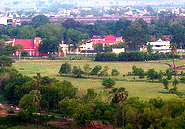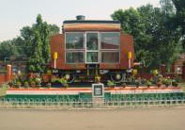Welcome to Jamalpur the world’s most beautiful place! Munger, Bihar
Welcome to Jamalpur ||Munger, BiharArchive for Jamalpur workshop
Improve Railways’ coal delivery for better returns
A mechanical engineer from the Indian Railway Institute of Mechanical & Electrical Engineering, Jamalpur (Bihar), Mr Kumar joined the Indian Railways in 1976 and took over as General Manager of the SECR November.
South Eastern Railway’s (SER) erstwhile Bilaspur Division, then the country’s largest freight-loading railway division, became the headquarters of a new zonal railway, South East Central Railway (SECR), on April 1, 2003, following trifurcation of the SER.
Today, the SECR is the single largest freight-loading (read, coal loading) zone of the Indian Railways.
In 2011-12, SECR handled 150.7 million tonnes (mt) of traffic, including 112 mt of coal.
Targets
The targets for the current year have been set at 158 mt and 118 mt respectively.
The targets, though achievable, are not without challenges, Mr Arunendra Kumar, General Manager of SECR, tells Business Line, drawing attention to a 0.4 mt drop in coal throughput in the first quarter vis-à-vis the same period of last year.
A mechanical engineer from the Indian Railway Institute of Mechanical & Electrical Engineering, Jamalpur (Bihar), Mr Kumar joined the Indian Railways in 1976 and took over as General Manager of the SECR November.
The SECR has embarked on a multi-pronged strategy to boost loading.
The strategy, according to Mr Kumar, presupposes having new private sidings to load more raw as well as washed coal, helping public sector coal companies tackle railway problems, launching new projects, speeding up implementation of projects on hand and upgrading the delivery system.
No rake shortage
Mr Kumar makes it clear that his railway does not suffer from a shortage of rakes.
“As many as 90 rakes are available every day for coal loading, with at least 25 per cent of them idling,” he says, asking, “Where is coal?” As he points out, out of the nine sidings of Mahanadi Coalfields in Ib Valley served by the SECR, only one has two-and-a-half days’ stock while others are living virtually hand-to-mouth.
In April, there was no coal for loading due to various reasons, including the dispute over payments between the washeries and their customers.
The SECR, though accounting for 72 per cent of total coal loading in areas served by it, is not connected to many pitheads directly and the rake loading in respect of these mines has to be supported by road-bridging, which is not the responsibility of the railways.
Overall, loading by coal companies has been unsatisfactory.
The coal companies hardly bother to properly maintain their own rail networks. They outsource the job with predictable consequences.
Derailments
Derailment is a regular feature and one derailment cripples movement for several hours. Last year, about 85 derailments hit the SECR’s coal movement.
“SECR, therefore, is assisting the coal companies concerned to upgrade their railway systems.
“A beginning has been made with the renovation of a 3-km-long railway line at Odisha’s Brojorajnagar under Mahanadi Coalfields Ltd at a cost of Rs 5.6 crore and a similar exercise is likely soon at Korba (Chhattisgarh) under South East Central Coalfields Ltd.
“We want coal companies to deploy more pay-loaders as it is possible to complete loading a rake of 59 wagons in two to two-and-a-half hours as against four to five hours at present by deploying five pay-loaders and thus achieving a 50 per cent jump in efficiency.
“Assuming such an improvement is difficult to sustain throughout the year, partial success yielding at least a 25 per cent improvement too will mean a lot. But then, deployment of pay-loaders is a contractual matter between coal companies and equipment suppliers.”
New projects
As for new projects, the Chhattisgarh Government has identified three railway corridors mainly to facilitate coal loading (with limited passenger services) and is serious about their early implementation.
Two of these projects, namely, the 85-km long Eastern Corridor between Bhupdeopur and Khargoda and the 122-km-long East West Corridor between Korba and Pendra Road, are receiving top priority with several rounds of discussion already held between the Chairman of the Railway Board (Indian Railways will hold 26 per cent equity stake in the special purpose vehicle to be formed to implement the projects), the Union Coal Secretary, the Chairman of Coal India Ltd and the Chief Minister, Dr Raman Singh.
land acquisition
However, land acquisition remains a big issue and, precisely for this reason, the extent of equity participation by the State Government, the coal company (most probably South East Central Coalfields Ltd, a subsidiary of Coal India) and even private firms, the prospective beneficiaries of the projects, are yet to be finalised.
The State Government’s participation will be by way of making land available.
The two major projects in hand include construction of a third line over a 485-km stretch between Jharsuguda and Gondia and a second line, over 42-km-long, on the 150-km Bilaspur-Katni line, also known as the CIC line.
Resources
There has been a delay in implementing the projects. Resource is a major constraint but there are other problems.
For example, the work on the CIC line was held up for more than two years due to the delay in getting a forest clearance.
“Also, it is not easy to undertake new construction alongside the existing lines on which normal movement has to be maintained with the number of trains increasing every year,” he says.
The delivery system improvement is sought to be achieved in several ways, namely, easing the gradients in certain sections (with five such sections having been identified and work on a pilot project near Nagpur already started), breaking long sections into two by signaling improvement (known as IBH, or intermediate block hut), and introducing more long-haul trains, that is, clubbing two freight trains into one that comprises 118 wagons.
Long-haul trains
Right now, the SECR operates 10 such long-haul trains, mostly empties, on the Bhilai-Korba route. The plan is to club three rakes into one for operation on the same route.
“We have problems, the most important being the capacity constraint, but we must find ways to overcome them and, if necessary, relocate resources to projects yielding better returns faster,” Mr Kumar observes.
Source: http://www.thehindubusinessline.com/industry-and-economy/logistics/article3669923.ece
Railways set to modernize 150-yr-old Jamalpur workshop
The railways has chalked out an ambitious plan for modernization of the 150-year-old railway workshop at Jamalpur in Munger district at an estimated cost of Rs 117.46 crore.
Under the new plan, the railways would further improve its infrastructure to cope with the demands of new technology to manufacture rail components as well as to carry out maintenance work of locomotives, cranes and wagons smoothly.
According to chief works manager (CWM) Animesh Sinha, the Jamalpur workshop had come into being on February 8, 1862. It was the first workshop of the country to manufacture steam engine CA 764 `Lady Curzon’ in 1899 at a cost of Rs 33,000 only. Besides, it was the first to establish a rail foundry in 1893 whereas it had set up a rolling mill in 1870 to fulfill the needs of the railways, he said.
Source: TOI
















